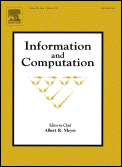 | |
| Discipline | Computer Science |
|---|---|
| Language | English |
| Edited by | Albert R. Meyer |
| Publication details | |
Former names | Information and Control |
| History | 1957–present |
| Publisher | |
| Frequency | monthly |
| no | |
| 1.24 (2021) | |
| Standard abbreviations | |
| ISO 4 | Inf. Comput. |
| MathSciNet | Inform. and Comput. |
| Indexing | |
| ISSN | 0890-5401 |
| Links | |
Information and Computation is a closed-access computer science journal published by Elsevier (formerly Academic Press). The journal was founded in 1957 under its former name Information and Control and given its current title in 1987. As of July 2022 [update] , the current editor-in-chief is David Peleg. The journal publishes 12 issues a year.